Search the Special Collections and Archives Portal
Search Results

Photograph of charter officers for the new North Las Vegas Exchange Club, North Las Vegas, Nevada, July 31, 1972
Date
1972-07-31
Archival Collection
Description
Charter officers of new North Las Vegas Exchange Club, North Las Vegas, Nevada, July 31, 1972. Pictured L-R: Noel Thompson, President; Richard Cross, Vice-President; Bill Cyphers, Board Member; Warren Wilson, Secretary; Roland Bobier, Board Member; Gary Gray, Board Member.
Image
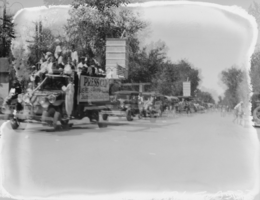
Film transparency of the Las Vegas Review-Journal Press Car entry in the Labor Day Parade, Las Vegas, Nevada, circa 1930
Date
1928 to 1932
Archival Collection
Description
A Labor Day Parade in Las Vegas, Nevada. A Press Car for the Las Vegas Review-Journal is visible, circa 1930. The original image has been damaged.
Image
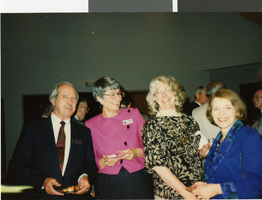
Photograph of Duane Pierce, Mary Harrison, Shirley Hurt and an unidentified woman at a University Library Society reception, Las Vegas, Nevada, circa 1991-1992
Date
1991 (year approximate)
Archival Collection
Description
L-R: Duane Pierce (Chairman of the University of Nevada, Las Vegas Department of Radiologic Technology), Mary Harrison (University of Nevada, Las Vegas Libraries librarian), Shirley Hurt, an unidentified woman at a University Library Society reception, Las Vegas, Nevada.
Image
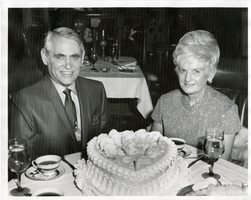
Photograph of Oran K. Gragson and his wife Bonnie celebrating his birthday at the Flamingo Hotel and Casino, Las Vegas, Nevada, 1969
Date
1969
Archival Collection
Description
Oran K. Gragson and his wife Bonnie celebrating his birthday at the Flamingo Hotel and Casino, Las Vegas, Nevada, 1969. Oran Kenneth Gragson (February 14, 1911 – October 7, 2002) was an American businessman and politician. He was the longest-serving mayor of Las Vegas, Nevada, from 1959 to 1975. Gragson, a member of the Republican Party, was a small business owner who was elected Mayor on a reform platform against police corruption and for equal opportunity for people of all socio-economic and racial categories. Gragson died in a Las Vegas hospice on October 7, 2002, at the age of 91. The Oran K. Gragson Elementary School located at 555 N. Honolulu Street, Las Vegas, NV 89110 was named in his honor.
Image
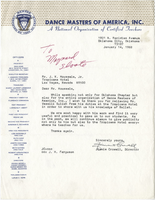
Letter from Jimmie Crowell (Oklahoma City, Oklahoma) to J.K. Houssels, Jr., (Las Vegas, Nevada), January 14, 1968
Date
1968-01-14
Archival Collection
Description
Letter from Jimmie Crowell, Director of the Oklahoma Chapter of Dance Masters of America, Inc., to J.K. Houssels, Jr., at the Tropicana Hotel in Las Vegas, Nevada, thanking Houssels for allowing Vassili Sulich time from his performances at the Tropicana to teach DMA students. Letter on Dance Masters of America, Inc. letterhead. Handwritten on letter "To Maynard Sloate."
Text
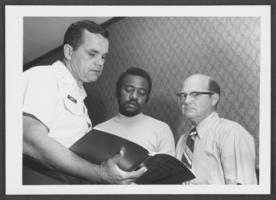
Photograph of Colonel Harold Dortch and two businessmen at a small business seminar at Nellis Air Force Base, Nevada, May 26, 1976
Date
1976-05-26
Archival Collection
Description
Left to right: Col. Harold Dortch with businessmen Ernest Phillips and Floyd Conn, at a small business seminar at Nellis Nellis Air Force Base, Nevada. Site Name: Nellis Air Force Base (Nev.)
Image
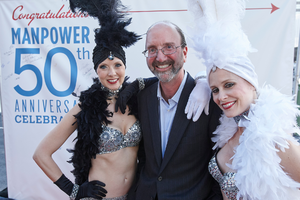
Photograph of Andy Katz at Manpower Las Vegas' 50th anniversary celebration, Las Vegas, Nevada, April 09, 2015
Date
2015-04-09
Archival Collection
Description
Manpower Las Vegas President Andy Katz poses with showgirls on the red carpet during his company's 50th anniversary celebration at its downtown Las Vegas headquarters.
Image
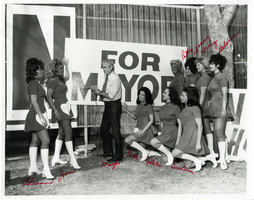
Photograph of Oran K. Gragson putting up a poster for his re-election campaign, Las Vegas, Nevada, circa 1960s
Date
1960 to 1969
Archival Collection
Description
Oran K. Gragson putting up a poster for his re-election campaign. He is being assisted by female campaign workers. The women are identified as L-R: (standing, left of Mayor Gragson) Adrian, Joanie, Mayor Gragson (center), (kneeling in front) L-R: Darla, Gretchen, Sue Ann (standing in back, on right) L-R: Patsy, Nancy, Mary, and Delores. Oran Kenneth Gragson (February 14, 1911 – October 7, 2002) was an American businessman and politician. He was the longest-serving mayor of Las Vegas, Nevada, from 1959 to 1975. Gragson, a member of the Republican Party, was a small business owner who was elected Mayor on a reform platform against police corruption and for equal opportunity for people of all socio-economic and racial categories. Gragson died in a Las Vegas hospice on October 7, 2002, at the age of 91. The Oran K. Gragson Elementary School located at 555 N. Honolulu Street, Las Vegas, NV 89110 was named in his honor.
Image
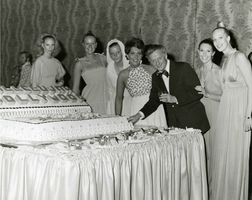
Photograph of opening night party for Donn Arden's "Hallelujah Hollywood!" MGM Grand, Las Vegas, Nevada, 1974
Date
1974
Archival Collection
Description
Donn Arden cutting a cake, with guests at an opening night party for his production "Hallelujah Hollywood!" at the MGM Grand Hotel and Casino. L-R: unidentified; Jackie Matthews; unidentified; Diane Findley (brunette); Donn Arden; Eileen Barnett; Tricia Lee.
Image

Film transparency of Mr. L. J. (Lewis J.) Murphy and the famous Tom Kelly Bottle House in Rhyolite, Nevada, November 25, 1948
Date
1948-11-25
Archival Collection
Description
Mr. L. J. (Lewis J.) Murphy and the famous Tom Kelly Bottle House in Rhyolite, Nevada, which he operated as a free museum in the old ghost town. L. J. Murphy took care of the Bottle House from 1929 until his death in 1953. Two wagon wheels are visible in the front yard. Rhyolite is a ghost town in Nye County, Nevada. It is in the Bullfrog Hills, about 120 miles (190 km) northwest of Las Vegas, near the eastern edge of Death Valley. The town began in early 1905 as one of several mining camps that sprang up after a prospecting discovery in the surrounding hills. During an ensuing gold rush, thousands of gold-seekers, developers, miners and service providers flocked to the Bullfrog Mining District. Many settled in Rhyolite, which lay in a sheltered desert basin near the region's biggest producer, the Montgomery Shoshone Mine. Rhyolite declined almost as rapidly as it rose. After the richest ore was exhausted, production fell. The 1906 San Francisco earthquake and the financial panic of 1907 made it more difficult to raise development capital. In 1908, investors in the Montgomery Shoshone Mine, concerned that it was overvalued, ordered an independent study. When the study's findings proved unfavorable, the company's stock value crashed, further restricting funding. By the end of 1910, the mine was operating at a loss, and it closed in 1911. By this time, many out-of-work miners had moved elsewhere, and Rhyolite's population dropped well below 1,000. By 1920, it was close to zero. After 1920, Rhyolite and its ruins became a tourist attraction and a setting for motion pictures. Most of its buildings crumbled, were salvaged for building materials, or were moved to nearby Beatty or other towns, although the railway depot and a house made chiefly of empty bottles were repaired and preserved. The town is named for rhyolite, an igneous rock composed of light-colored silicates, usually buff to pink and occasionally light gray. It belongs to the same rock class, felsic, as granite but is much less common.
Image
Pagination
Refine my results
Content Type
Creator or Contributor
Subject
Archival Collection
Digital Project
Resource Type
Year
Material Type
Place
Language
